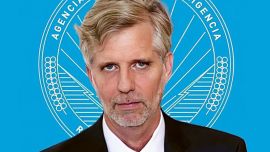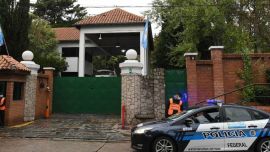Barefoot and hunched over, Ruben Gutiérrez Escobar, 63, plunges his hoe into the dark soil of his maize field in Bella Vista at an altitude of 3,500 metres in the Peruvian Andes, south of Cusco. He uses no tractor or fertiliser, "just sweat, work and sacrifice."
"Lima is oblivious to us," he says.
The riots that have left 48 people dead in Peru since last December are a reflection of the huge rift between the capital and the Andes, where most of the protesters who are demanding the resignation of the president and new elections reside.
The political crisis erupted on December 7 with the impeachment and arrest of the leftist president Pedro Castillo, who is of indigenous and Andean origin. The president attempted a coup d'état by dissolving Congress, which was about to vote on his impeachment. He was then replaced by his Vice-President, Dina Boluarte.
Ruben is part of poor, Indigenous Peru, forgotten by political elites in Lima. He gets up at three in the morning to look after his five cows and seven sheep, working until sunset in a field where he grows potatoes, beans and maize for his own consumption. He goes to bed at ten o'clock at night.
He earns between 20 and 25 soles a day – about US$6 – selling "between 5 and 10 litres of milk." "We never get a good enough harvest to live on," he says.
Gold mines and poverty
Despite the poverty of its people, almost all of Peru's wealth lies in the Andes: from the gold, copper, silver and tin deposits to the resources generated by tourism in the Inca citadel of Machu Picchu.
Like many protesters, Ruben wonders: "There is talk of a mining canon [which belongs to the state], but where does it all go? Almost all the income goes to Lima and is lost in Lima. We don't get a single cent here," he says, angry.
"We don't have any support from the state," he laments. The farmer says he has never received any help or advice from an agronomist or veterinary service, despite having asked for it. He has stopped using unsubsidised fertilisers since the war in Ukraine increased prices sixfold.
He also criticises the lack of infrastructure, health services and education in the country. "It is said that the hospital is free. It is false, 100 percent false. You have to spend your money," he explains.
Ruben regrets not having been able to give "an education" or a trade "to at least one" of his three children. "It was out of my reach," he stresses.
People here ask themselves: "How is it possible that we, being the owners of the gas, don't have gas, that being that we all own the mining and have the famous mining taxes, we don't have good schools or good hospitals," says anthropologist Julio Edmundo Oliveira, from the University of Cusco.
"The pandemic (COVID-19) two years ago uncovered all these things," he adds.
"It's a structural problem that didn't start yesterday. It is not the fault of Pedro Castillo or Dina Boluarte," he says, pointing out that the root of the problem lies in the shortcomings of the state.
"Cusco, capital of the Inca civilisation, developed from Andean culture. After independence in 1821, the Peruvian Republic developed from Lima's centralism," he explains. The latter, he says, never bothered to set up good schools, or good lycées, in remote areas.
"They never invested in the Andes, when in fact the Andes support the capital," he adds.
The anthropologist cites the example of Cerro de Pasco, a nearly exhausted mining complex in the Andes, 250 kilometres from Lima at an altitude of 4,200 metres. "People have lead in their lungs but there are no hospitals, no high schools, no good universities. Cerro de Pasco is one of the poorest areas in the country. A disgrace," he says.
Inca blood
In the Angostura neighbourhood of Cusco, Ruben Mina, a 53-year-old taxi driver, queues in vain to buy gas. The blockades and demonstrations have caused shortages, but he is also protesting against the president and Congress.
"Boluarte has prejudice in her head, she thinks most of the people are ignorant, especially those of us from the highlands. There is a country called Lima and another that is Peru," he says angrily.
In Cusco's Tupac Amaru square, at the foot of the imposing black statue of the Inca chief who fought against the Spanish colony, demonstrators raise Peruvian and Andean flags. They shout: "We have Inca blood, we are not terrorists!"
Lima's leaders and elites often call the protesters "terrorists," sometimes alluding to the Shining Path, the communist party of Peru, which claimed indigenous origins. "We are the Inca blood, we are the Quechua nation, we are heirs to the Andean resistance that has been fighting since colonial times," explains Javier Cusimayta Osca, a teacher who takes part in the demonstrations.
"There is contempt for Lima. There is a centralism as strong as in colonial times. They want us to believe that Lima is Peru, but it is only a part of Peru, like Cusco or Madre Dios," he adds, before concluding in Quechua: "Hoq Saqmalla! Hoq Kallpalla! Hoq Sonqolla!" ("One fist! One force! One heart!")
related news
by Patrick Fort, AFP



















Comments